
Robert Lea
Robert Lea is a science journalist in the U.K. whose articles have been published in Physics World, New Scientist, Astronomy Magazine, All About Space, Newsweek and ZME Science. He also writes about science communication for Elsevier and the European Journal of Physics. Rob holds a bachelor of science degree in physics and astronomy from the U.K.’s Open University. Follow him on Twitter @sciencef1rst.
Latest articles by Robert Lea
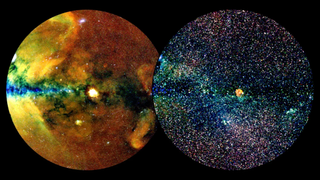
X-ray image of universe reveals almost 1 million high-energy objects: 'These are mind-blowing numbers'
By Robert Lea published
"The scientific breadth and impact of the survey is quite overwhelming; it’s hard to put into a few words."

How do galaxies grow while ensnared in the universe's cosmic web?
By Robert Lea published
Scientists want to know how galaxies get ensnared in the universe's 'cosmic web' and how this network of filamentary gas and dust drives galactic evolution.

Meteorites from Asteroid 2024 Bx1, which just hit Earth, may be super-rare space rocks
By Robert Lea published
Fragments of the Asteroid 2024 BX1 that rained down on Berlin have been recovered by intrepid meteorite hunters, and it turns out the rocks may be incredibly rare.

Astronomers witness 18 ravenous black holes ripping up and devouring stars
By Robert Lea published
Astronomers have discovered 18 new cases of black holes ripping up and devouring stars, more than doubling the number of known tidal disruption events found in the local universe.
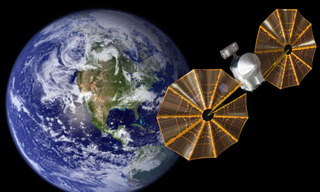
NASA's Lucy asteroid probe to fire main engines in space for 1st time this week
By Robert Lea published
NASA's Lucy mission will fire its main engines for the first time on Wednesday (Jan. 31.)

NASA's TESS telescope spots 6 exoplanets around 'misbehaving' toddler star
By Robert Lea published
NASA's TESS telescope has discovered a system of six young exoplanets that race around a newborn star, offering a snapshot of what our solar system looked like 4 billion years ago.

Are they exomoons or not? Scientists debate existence of 1st moons seen beyond our solar system
By Robert Lea published
Recent research suggested the first and only moons seen around planets outside the solar system didn't actually exist; now, the scientists who initially found them are back to defend their discovery.

Hubble Telescope spies massive 'bridge of stars' connecting 2 galaxies on collision course (image)
By Robert Lea published
The Hubble Space Telescope has imaged a 250,000-light-year-long 'bridge of stars' stretching through the Arp 295 galactic grouping that was pulled away from one galaxy as it interacted with another.

James Webb Space Telescope observes 19 intricate galaxy structures in stunning detail (images)
By Robert Lea published
The James Webb Space Telescope has observed the glowing gas and dust patterns of 19 spiral galaxies in stunning detail, aiming to uncover the origins of these intricate structures.

1st gravitational wave detector in space 'LISA' will hunt for ripples in spacetime
By Robert Lea published
The triple-spacecraft gravitational wave detector, named LISA, has received the go-ahead to become the first mission to detect spacetime ripples from space.

How blockchain technology could help reveal the origins of life
By Robert Lea published
Scientists have investigated the chemistry needed to give rise to prebiotic molecules that led to the emergence of life on early Earth using blockchain technology.

'Trainwreck' galaxy reflects the aftermath of a violent galactic collision (image)
By Robert Lea published
The "peculiar," twisted galactic disk of the "trainwreck" lenticular galaxy NGC 4753 offers evidence of its violent collision with a dwarf galaxy over 1 billion years ago.

Hidden star discovery reveals 'old smokers' and 'screaming' newborns
By Robert Lea published
While monitoring around a billion Milky Way stars over 10 years, astronomers discovered a new ancient red star type along with a bunch of violently erupting newborn protostars.

Does the sun move in the solar system?
By Robert Lea published
Space mysteries We know the sun is currently zooming through space, but does it move within our solar system?

January's Full Wolf Moon looks stunning in 1st full moon photos of 2024 (photos)
By Robert Lea published
As the frigid weather of January bared its teeth, skywatchers captured some incredible images of the Wolf Moon, the first full moon of 2024.

Messenger comets might be why Earth has life, asteroid Ryugu samples suggest
By Robert Lea published
Samples of the asteroid Ryugu, returned to Earth by the Hayabusa2 mission, carry evidence that organic molecules important to life were once delivered to Earth by comets.
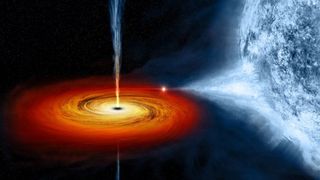
Vampire black hole is a 'cosmic particle accelerator' that may solve a longstanding astronomy mystery
By Robert Lea published
A distant microquasar, composed of a black hole feeding on a companion star, has jets that create shockwaves. These waves could accelerate the particles found in cosmic rays that bombard Earth.

'We proved that you can land wherever you want.' Japan's SLIM moon probe nailed precise lunar landing, JAXA says
By Robert Lea published
Japan's SLIM spacecraft made a strange but precise lunar landing, touching the moon with the tip of its nose as it landed incredibly close its target location.

Hubble telescope spots water around tiny hot and steamy exoplanet in 'exciting discovery'
By Robert Lea published
The Hubble Space Telescope has spotted water in the atmosphere of a tiny planet with temperatures around that of Venus, meaning it's a hot and steamy world.

Could space salad jeopardize a mission to Mars?
By Robert Lea published
Salad may not be the healthiest meal for astronauts as scientists discover lettuce flesh can be easily plagued with disease-causing pathogenic bacteria and fungi on the ISS.
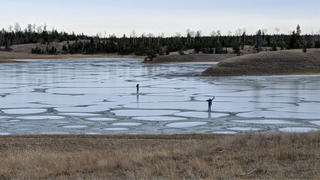
A shallow lake in Canada could reveal how life on Earth began
By Robert Lea published
A shallow soda lake in Canada could resemble Darwin's 'warm little ponds' found on the primordial Earth that had the right chemistry for life to get started.
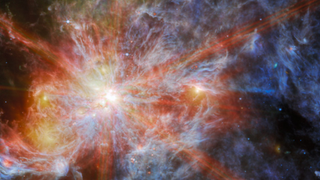
Nearby star factory shines in stunning James Webb Space Telescope photo
By Robert Lea published
The James Webb Space Telescope has zoomed in on N79, a 1,630-light-year-wide star birthing complex in the Large Magellanic Cloud, to produce a stunning image.

Rhea: A guide to Saturn's 'rocky snowball' moon
By Robert Lea last updated
Reference Rhea, Saturn's second-largest moon, is a rocky snowball that has its own ring system and a weird "two-faced" surface.

Are gaps in the Andromeda galaxy filled with dark matter? This NASA telescope could find out
By Robert Lea published
NASA's forthcoming Nancy Grace Roman Space Telescope will zoom in on streams of stars in the Andromeda galaxy to hunt for dark matter.
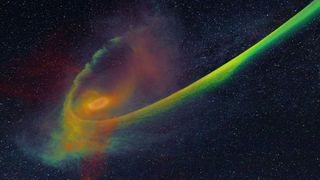
Gory simulation reconstructs violent clash as a monster black hole spaghettifies star from start to finish
By Robert Lea published
A new cosmic crime scene reconstruction tells the full story of a star ripped apart by a ravenous black hole, revealing a previously unknown aspect of these tidal disruption events.
